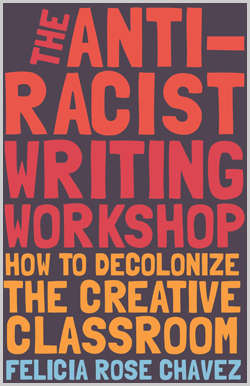The Anti-Racist Writing Workshop: How to Decolonize the Creative Classroom
by Felicia Rose Chavez
by JP Poole
When Felicia Rose Chavez was a student in The University of Iowa’s nonfiction program, she sat in a workshop and listened to other students complain that they didn’t understand her work. As is common in writing workshops, she listened in silence, forced to absorb the negative comments lobbed her way. Chavez cites Beth Nguyen, who also spent a workshop session in silence, as participants talked about not knowing what dim sum was and how it made “the whole piece confusing.” Students of color are tasked with both explaining their experience to white audiences and making those experiences palatable enough for white audiences to understand.
 “Silencing writers is central to the traditional writing workshop model,” Chavez writes; it dates back to 1936, when Iowa became the first degree-granting program for writing. With primarily white faculty, students, and reading list, the workshop has long been a space for “safeguarding whiteness as the essence of literary integrity.”
“Silencing writers is central to the traditional writing workshop model,” Chavez writes; it dates back to 1936, when Iowa became the first degree-granting program for writing. With primarily white faculty, students, and reading list, the workshop has long been a space for “safeguarding whiteness as the essence of literary integrity.”
Hierarchy, domination, white supremacy, and evaluating work in terms of good versus bad is toxic for creativity. Writers are expected to handle critique like a punch to the gut. This is especially troubling since the average workshop participant shares work “at best twice per semester” and other students “[undergo] zero training in how to offer critique.”
The Anti-Racist Writing Workshop is a stellar guide for how different models can be explored. In testing out a new way to workshop, Chavez asked herself: What if writers are allowed to speak? What if writers suggest what’s on the reading list? What if writers are allowed to ask for a particular type of feedback? (For example, “Please don’t edit my piece but feel free to comment on the structure.”)
Empowered writers are generous writers, they are able to be kinder to themselves and others, which only fosters more work, truer work, work that explores that infamous thing called a writer’s “voice.” As anti-racist workshop leaders, Chavez writes, we must “relinquish our stronghold on being right, and admit we can do better.”
During the pandemic, I’ve taught many workshops via zoom. The first day, I explain to writers that the workshop space is one where we support each other. I know it can sound a little gooey but I stand firm about noticing what the writer is doing—what stands out about their approach to art. Observation, not critique. I’m firm about refraining from comments such as “I didn’t like this…” I tell writers that kindness, patience, and time are the best ways to keep writing. The secret sauce is support.
There are a few things that Chavez suggests that I probably wouldn’t do, such as making students stand when they read. She also recommends that the workshop leader remain quiet during workshop and let students guide themselves. This fly-on-the -wall approach works for her; I’m not so sure that it would work for me, but I won’t know until I give it a try. The point of the book is to call upon workshop leaders to think about how they can best support workshoppers. A student-centered approach is an approach I deeply believe in.
Kiese Laymon writes that “[e]very writing teacher on Earth needs this book.” This is so true. At the end of the book, Chavez includes her lesson plans as a road map. The Anti-Racist Writing Workshop is filled with ingenuity, possibility, and hope—as one of her students notes, Felicia’s approach to teaching writing is the future. And the future looks bright.
